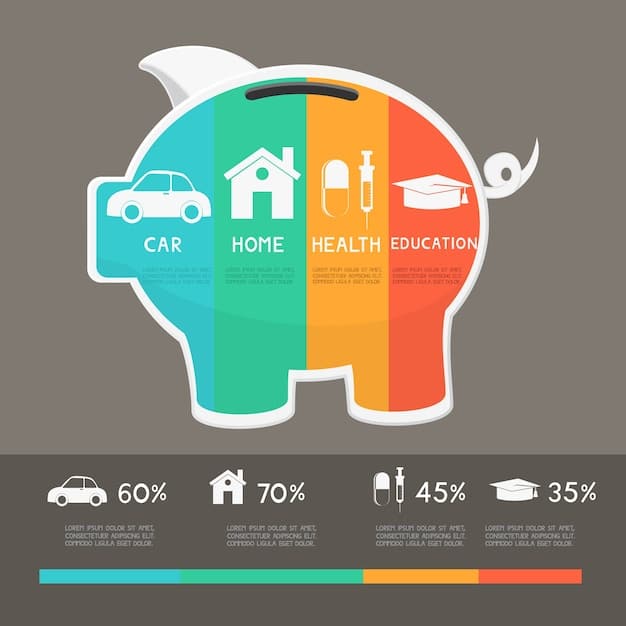Affordable Care Act in 2025: Is It Still the Best Option for US Residents?

Is the Affordable Care Act Still the Best Option? A 2025 Analysis for US Residents highlights the ongoing debate about the ACA’s effectiveness, exploring its current benefits, limitations, and potential alternatives for healthcare coverage in the United States.
Navigating the complexities of healthcare coverage can be daunting, especially when considering the Affordable Care Act (ACA). Is the Affordable Care Act Still the Best Option? A 2025 Analysis for US Residents seeks to answer the pivotal question of whether the ACA remains the most viable path to healthcare for Americans in the coming year.
Understanding the Affordable Care Act: A Refresher
The Affordable Care Act (ACA), also known as Obamacare, has been a cornerstone of US healthcare policy since its enactment in 2010. Understanding its core tenets is essential to evaluating its continued relevance in 2025.
Key Provisions of the ACA
The ACA aimed to expand health insurance coverage, regulate the insurance industry, and reduce healthcare costs. Its major provisions include:
- Individual Mandate: Originally requiring most individuals to have health insurance or face a penalty (later removed).
- Expansion of Medicaid: Allowing states to expand Medicaid eligibility to cover more low-income individuals.
- Creation of Health Insurance Marketplaces: Providing platforms for individuals and small businesses to purchase health insurance plans.
- Guaranteed Issue and Community Rating: Ensuring that insurers cannot deny coverage or charge higher premiums based on pre-existing conditions.
These provisions significantly reshaped the healthcare landscape, leading to increased coverage rates and greater consumer protections.
How the ACA Has Impacted Healthcare Access
The ACA has undoubtedly broadened access to healthcare for millions of Americans. By prohibiting insurers from denying coverage based on pre-existing conditions and offering subsidies to reduce premiums, the act has made health insurance more affordable and accessible.

However, challenges remain. Many individuals still struggle to afford coverage due to high deductibles and cost-sharing requirements. Additionally, the removal of the individual mandate penalty has led to concerns about adverse selection and rising premiums.
In summary, the ACA has brought about significant improvements in healthcare access, but its effectiveness is continually debated in light of its costs and evolving market dynamics.
The Current State of Healthcare Costs Under the ACA
One of the most pressing concerns surrounding the ACA is the cost of healthcare. While the ACA aimed to curb rising costs, many Americans continue to struggle with high premiums, deductibles, and out-of-pocket expenses.
Premiums and Deductibles in 2025
In 2025, premiums for ACA marketplace plans vary widely depending on factors such as location, age, and plan type. While subsidies are available to help lower premiums for eligible individuals and families, many still find the costs prohibitive.
Deductibles also remain a significant barrier to access. High-deductible health plans (HDHPs) are common in the ACA marketplace, requiring individuals to pay thousands of dollars out-of-pocket before their insurance coverage kicks in.
Factors Influencing Healthcare Costs
Several factors contribute to the high cost of healthcare in the US, including:
- Rising Prescription Drug Prices: The cost of prescription drugs continues to soar, driven by pharmaceutical company pricing strategies and limited regulation.
- Administrative Overhead: The US healthcare system has a high administrative overhead compared to other developed countries, adding to overall costs.
- Lack of Price Transparency: It can be difficult for consumers to compare prices for healthcare services, leading to inefficiencies and higher costs.
Addressing these factors is essential to making healthcare more affordable and accessible for all Americans.
In conclusion, while the ACA has expanded coverage, the issue of healthcare costs remains a significant challenge. Policymakers must consider comprehensive strategies to address the underlying drivers of rising costs and ensure that healthcare is affordable for everyone.
Alternatives to the ACA: Exploring Other Options
Given the ongoing debates about the ACA’s effectiveness and affordability, it’s important to explore potential alternatives that could provide better healthcare coverage for US residents.
Medicare for All
Medicare for All is a single-payer healthcare system in which the government finances healthcare for all residents. Proponents argue that this approach would simplify the system, reduce administrative costs, and ensure universal coverage.
However, critics raise concerns about the potential impact on private insurance companies, the role of government in healthcare, and the cost of implementing such a system.
Health Savings Accounts (HSAs)
Health Savings Accounts (HSAs) are tax-advantaged savings accounts that can be used to pay for healthcare expenses. HSAs are typically paired with high-deductible health plans (HDHPs), allowing individuals to save money for healthcare while also having insurance coverage.

HSAs can be a valuable tool for managing healthcare costs, but they may not be suitable for everyone. Individuals with chronic health conditions or high healthcare needs may prefer more comprehensive coverage options.
State-Based Healthcare Solutions
Some states are exploring their own healthcare solutions, such as state-based marketplaces and Medicaid expansion programs. These initiatives can be tailored to meet the specific needs of each state’s population.
For example, some states have implemented reinsurance programs to stabilize premiums in the ACA marketplace, while others have expanded Medicaid eligibility to cover more low-income individuals.
In summary, there are several alternatives to the ACA that could potentially provide better healthcare coverage for US residents. Each option has its own set of advantages and disadvantages, and policymakers must carefully consider the trade-offs involved.
The Impact of Political Changes on the ACA
The Affordable Care Act has been subject to numerous political challenges since its enactment, and future political changes could significantly alter its fate.
Legislative Efforts to Repeal or Replace the ACA
Republicans have historically sought to repeal or replace the ACA, arguing that it is too costly and ineffective. While previous repeal efforts have failed, future legislative action could once again threaten the ACA’s existence.
If the ACA were to be repealed, millions of Americans could lose their health insurance coverage, and consumer protections such as guaranteed issue and community rating could be eliminated.
Changes to Regulations and Enforcement
The executive branch also has the power to alter the ACA through changes to regulations and enforcement. For example, the Trump administration weakened enforcement of the individual mandate and expanded access to short-term, limited-duration insurance plans, which are not subject to the same consumer protections as ACA plans.
Future administrations could take similar actions to either strengthen or weaken the ACA, depending on their political priorities.
The Role of the Supreme Court
The Supreme Court has played a significant role in shaping the ACA’s future. In several landmark cases, the Court has upheld the ACA’s constitutionality, but future legal challenges could still arise.
The composition of the Supreme Court could also influence its decisions on healthcare policy. A more conservative Court could be more inclined to strike down provisions of the ACA or overturn it entirely.
In conclusion, the political landscape plays a critical role in determining the future of the ACA. Changes in legislation, regulations, and judicial rulings could have profound implications for healthcare coverage in the US.
Assessing the Long-Term Sustainability of the ACA
To determine whether the ACA is still the best option for US residents in 2025, it’s important to assess its long-term sustainability. This involves considering factors such as its financial stability, its impact on the insurance market, and its ability to adapt to changing healthcare needs.
Financial Stability of the ACA Marketplaces
The financial stability of the ACA marketplaces has been a concern since their inception. Insurers have faced challenges in accurately predicting healthcare costs, leading to fluctuations in premiums and market exits.
However, recent data suggests that the ACA marketplaces are becoming more stable. Premiums have stabilized in many areas, and more insurers are participating in the marketplaces.
Impact on the Insurance Market
The ACA has had a significant impact on the insurance market, leading to increased regulation and consolidation. Many smaller insurers have struggled to compete with larger players, leading to a more concentrated market.
This consolidation could have both positive and negative effects. On the one hand, it could lead to greater efficiency and lower costs. On the other hand, it could reduce competition and limit consumer choice.
Adapting to Changing Healthcare Needs
The healthcare landscape is constantly evolving, and the ACA must be able to adapt to changing needs. This includes addressing issues such as the aging population, the rise of chronic diseases, and the increasing role of technology in healthcare.
The ACA has some built-in mechanisms for adaptation, such as the Center for Medicare and Medicaid Innovation, which tests new payment and delivery models.
In summary, the long-term sustainability of the ACA depends on its ability to maintain financial stability, adapt to changing market conditions, and meet the evolving healthcare needs of the US population.
Making Informed Decisions About Healthcare Coverage in 2025
As US residents navigate the healthcare landscape in 2025, it’s essential to make informed decisions about coverage options. This involves understanding the pros and cons of the ACA, exploring potential alternatives, and considering individual healthcare needs and financial circumstances.
Understanding Your Healthcare Needs
Before choosing a health insurance plan, it’s important to assess your healthcare needs. Consider factors such as:
- Your Medical History: Do you have any chronic health conditions or need regular medical care?
- Your Family’s Health: Do you have children or other family members who need coverage?
- Your Budget: How much can you afford to spend on premiums, deductibles, and out-of-pocket expenses?
Answering these questions can help you narrow down your options and choose a plan that meets your needs and budget.
Comparing ACA Plans and Alternatives
Once you have a better understanding of your healthcare needs, you can begin comparing ACA plans and potential alternatives. Consider factors such as:
- Coverage: What services are covered by the plan?
- Cost: How much are the premiums, deductibles, and co-pays?
- Network: Does the plan have a network of doctors and hospitals that you can access?
You can use the ACA marketplace to compare plans and see if you are eligible for subsidies.
Seeking Professional Advice
Choosing a health insurance plan can be complex, and it’s often helpful to seek professional advice. Consider consulting with a healthcare navigator, insurance broker, or financial advisor to get personalized guidance.
These professionals can help you understand your options, compare plans, and make informed decisions about your healthcare coverage.
In conclusion, making informed decisions about healthcare coverage in 2025 requires a thorough understanding of the ACA, potential alternatives, and individual healthcare needs. By taking the time to research your options and seek professional advice, you can choose a plan that provides the coverage you need at a price you can afford.
| Key Point | Brief Description |
|---|---|
| ✅ ACA’s Core | Expanded access, regulated insurance, and aimed to lower costs. |
| 💰 Healthcare Costs | High premiums and deductibles remain a challenge under the ACA. |
| 💡 Alternatives | Medicare for All, HSAs, and state-based solutions are potential options. |
| 🏛️ Political Impact | Legislative, regulatory, and judicial changes can significantly affect the ACA. |
Frequently Asked Questions
▼
The ACA offers several key benefits, including expanded access to health insurance, protection against denial due to pre-existing conditions, and subsidies to help lower premium costs for eligible individuals.
▼
Eligibility for ACA subsidies is based on income and household size. You can check your eligibility by using the online calculator available on the ACA marketplace website or consulting with a healthcare navigator.
▼
Common complaints about the ACA include high premiums and deductibles, limited choice of plans in some areas, and the complexity of the enrollment process. Some also worry about its long-term financial sustainability.
▼
Alternatives to the ACA in 2025 include employer-sponsored health insurance, Medicare, Medicaid, Health Savings Accounts (HSAs), and various state-based healthcare programs. Each option has its own pros and cons depending on individual circumstances.
▼
Political changes, such as legislative actions or regulatory adjustments, can significantly impact the ACA. These changes could affect coverage options, subsidies, and consumer protections, so it is essential to stay informed.
Conclusion
In conclusion, determining whether Is the Affordable Care Act Still the Best Option? A 2025 Analysis for US Residents requires careful consideration of its benefits, limitations, and potential alternatives. While the ACA has expanded access to healthcare, challenges related to cost and political uncertainty persist, making it important for individuals to evaluate their options and make informed decisions about their healthcare coverage.





